Lowrance electronic PRO X51 User Manual
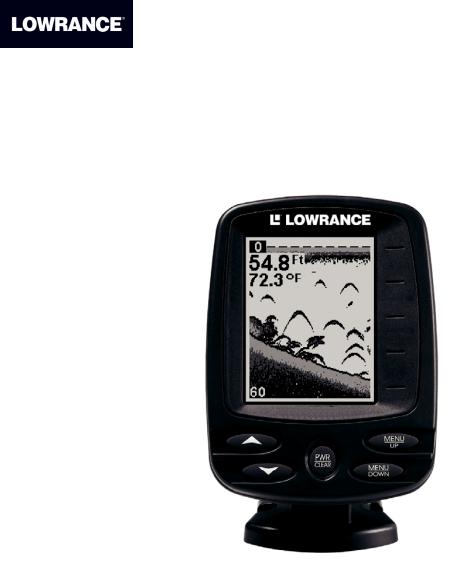
Pub. 988-0151-59A
X51 Pro
Fish-finding & Depth Sounding Sonar
Installation and Operation
Instructions
Copyright © 2008
Navico, Inc.
All rights reserved.
Lowrance® is a registered trademark of Navico, Inc. Marine-Tex™ is a trademark of Illinois Tool Works Inc.
Lowrance Electronics may find it necessary to change or end our policies, regulations, and special offers at any time. We reserve the right to do so without notice. All features and specifications subject to change without notice. All screens in this manual are simulated. On the cover: X51 Pro shown.
For free owner's manuals and other information, visit our web site:
www.lowrance.com
Lowrance Electronics Inc.
12000 E. Skelly Dr.
Tulsa, OK USA 74128-2486
Printed in USA.
Table of Contents |
|
Capabilities and Specifications: X51 Pro..................................... |
2 |
Section1: Installation................................................................ |
3 |
Installation Preparations.............................................................. |
3 |
Transducer Installation ................................................................ |
3 |
Transom Transducer Assembly and Mounting ........................... |
7 |
Trolling Motor Bracket Installation........................................... |
10 |
Transducer Orientation and Fish Arches.................................. |
12 |
Shoot-Thru Hull Preparation ..................................................... |
12 |
Power and Cable Connections .................................................... |
16 |
Mounting the Sonar Unit (Bracket and Portable) .................... |
17 |
Portable Transducer Assembly............................................... |
20 |
Section 2: Operation................................................................ |
21 |
Menus........................................................................................... |
22 |
Display ......................................................................................... |
22 |
Chart Scroll.............................................................................. |
23 |
Full Chart .................................................................................... |
23 |
Depth Range Zoom ...................................................................... |
24 |
Zoom ............................................................................................. |
24 |
Sensitivity.................................................................................... |
25 |
Grayline®.................................................................................. |
26 |
Fish I.D.™................................................................................ |
27 |
Fishtrack™ .............................................................................. |
27 |
Chart Scroll Speed....................................................................... |
28 |
Noise Reject and ASP™ (Advanced Signal Processing) ............ |
28 |
Pro Tips........................................................................................ |
28 |
Alarms.......................................................................................... |
28 |
Fish Alarm ............................................................................... |
28 |
Depth Alarms........................................................................... |
29 |
Shallow Alarm ......................................................................... |
29 |
Deep Alarm .............................................................................. |
29 |
Backlight...................................................................................... |
30 |
Display Contrast ......................................................................... |
30 |
Battery Voltage ........................................................................... |
30 |
Depth Units of Measure.............................................................. |
30 |
Preset Unit................................................................................... |
30 |
System Info .................................................................................. |
30 |
Simulator ..................................................................................... |
31 |
Digital Data Size (Depth and Temp).......................................... |
31 |
Index ........................................................................................... |
32 |
Troubleshooting....................................................................... |
33 |
1
Capabilities and Specifications: X51 Pro
|
General |
Case size:........................... |
5.8" H x 4.3" W x 2.5" D (14.7 cm H x 10.8 cm |
|
W x 6.6 cm D). Sealed, waterproof; suitable for |
|
saltwater use. |
Display: ............................ |
High-contrast Film SuperTwist LCD. |
|
Diagonal viewing area: 4.0" (10.2 cm). |
Resolution:.......................... |
168 pixels (vert.) x 132 pixels (horiz.) resolution; |
|
22,176 total pixels; 4-level gray scale. |
Backlighting: .................. |
Backlit screen and keypad for night use. |
Input power: ................... |
10 to 15 volts DC. |
Current drain: ................ |
110 ma lights off; 250 ma lights on. |
Back-up memory:........... |
Built-in memory stores sonar settings when |
|
unit is turned off. |
|
Sonar |
Frequency: ...................... |
200 kHz. |
Transducers:................... |
A Skimmer® transducer comes packed with |
|
your sonar unit. Its 20° cone angle offers a |
|
wide fish detection area of up to 60º with |
|
high sensitivity settings. Operates at boat |
|
speeds up to 70 mph (61 kts). |
Transmitter:.................... |
800 watts peak-to-peak; 100 watts RMS. |
Sonar sounding |
600 feet (180 meters). Actual capability |
depth capability:............ |
|
|
depends on transducer configuration and |
|
installation, bottom composition and water |
|
conditions. All sonar units typically read |
|
deeper in fresh water than in salt water. |
Depth display: ................ |
Continuous digital readout. |
Audible alarms:.............. |
Deep/shallow/fish. |
Automatic depth |
Yes. |
ranging:............................ |
|
Auto bottom track: ........ |
Yes. |
Zoom bottom track:....... |
Yes. |
Surface water temp:...... |
Yes, when transducer with attached temp |
|
sensor is used. |
|
2 |
Section 1: Installation
Thank you for buying a Lowrance® sonar! Your unit is a high quality sonar designed for both professional and novice fishermen. All Lowrance sonars have an automatic mode that finds and displays the bottom, fish, underwater structure and more – right out of the box. All you have to do is press the on (PWR) key.
NOTICE!
The storage and operation temperature range for your unit is from -4 degrees to +167 degrees Fahrenheit (-20 degrees to +75 degrees Celsius). Extended storage or operation in temperatures higher or lower than specified will damage the liquid crystal display in your unit. This type of damage is not covered by the warranty. For more information, contact the factory's Customer Service Department; phone numbers are inside the manual's back cover.
Installation Preparations
You can install the sonar system in some other order if you prefer, but we recommend this installation sequence:
Caution:
You should read over this entire installation section before drilling any holes in your vessel!
1.Determine the approximate location for the sonar unit, so you can plan how and where to route the cables for the transducer and power. This will help you make sure you have enough cable length for the desired configuration.
2.Determine the approximate location for the transducer and its cable route.
3.Determine the location of your battery or other power connection, along with the power cable route.
4.Install the transducer and route the transducer cable to the sonar unit.
5.Install the power cable and route it to the sonar unit.
6.Mount the sonar unit.
Transducer Installation
These instructions will help you install your Skimmer® transducer on a transom, on a trolling motor or inside a hull. Read these instructions carefully before attempting the installation. Determine which of the
3
installation methods is right for your boat. Use extreme care if mounting the transducer inside the hull, because once it is epoxied into position, the transducer usually cannot be removed.
Remember, the transducer installation is the most critical part of a sonar installation!
Your Skimmer transducer typically comes packaged with a one-piece stainless steel bracket for mounting it to the transom of your boat. The optional trolling motor mount uses a one-piece plastic bracket with an adjustable strap. These are "kick-up" mounting brackets. They help prevent damage if the transducer strikes an object while the boat is moving. If the transducer does "kick-up," the bracket can easily be pushed back into place without tools.
Recommended Tools and supplies
If you prefer the option of routing the cable through the transom, you will need a 5/8" drill bit. The following installation types also call for these recommended tools and required supplies (supplies are not included):
Transom installation
Tools include: two adjustable wrenches, drill, #29 (0.136") drill bit, flathead screwdriver. Supplies: high quality, marine grade aboveor belowwaterline sealant/adhesive compound.
Trolling motor installations
Tools: two adjustable wrenches, flat-head screwdriver. Supplies: plastic cable ties.
Shoot-through hull installations
Tools: these will vary depending on your hull's composition. Consult your boat dealer or manufacturer. Other tools are a wooden craft stick or similar tool for stirring and applying epoxy, and a paper plate or piece of cardboard to mix the epoxy on. Supplies: rubbing alcohol, 100 grit sandpaper, specially formulated epoxy adhesive available from LEI (see ordering information inside the back cover of this manual). A sandwich hull also requires polyester resin.
Selecting a Transducer Location
1.The location must be in the water at all times, at all operating speeds.
2.The transducer must be placed in a location that has a smooth flow of water at all times. If the transducer is not placed in a smooth flow of water, interference caused by bubbles and turbulence will show on the sonar's display in the form of random lines or dots whenever the boat is moving.
4
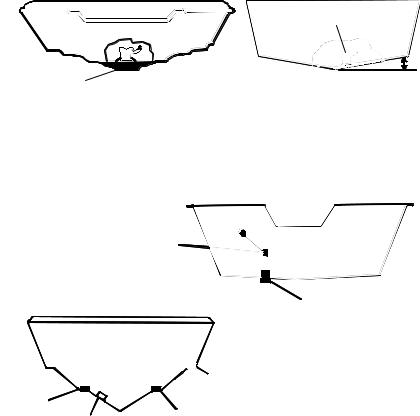
NOTE:
Some aluminum boats with strakes or ribs on the outside of the hull create large amounts of turbulence at high speed. These boats typically have large outboard motors capable of propelling the boat at speeds faster than 35 mph. Typically, a good transom location on aluminum boats is between the ribs closest to the engine.
3.The transducer should be installed with its face pointing straight down, if possible. For shoot-thru applications: Many popular fishing boat hulls have a flat keel pad that offers a good mounting surface. On vee hulls, try to place the transducer where the deadrise is 10° or less.
Deadrise less than 10°
 Strakes
Strakes
Pad
Left, vee pad hull; right, vee hull. A pod style transducer is shown here, but the principle is the same for Skimmers inside a hull.
4.If the transducer is mounted on the transom, make sure it doesn't interfere with the trailer or hauling of the boat. Also, don't mount it closer than approximately one foot from the engine's lower unit. This will prevent cavitation (bubble) interference with propeller operation.
CAUTION: Clamp the transducer cable to transom near the transducer. This will help prevent the transducer from entering the boat if it is knocked off at high speed.
Good location
|
Poor location |
Good |
|
location |
Good location |
Poor angle |
Good and poor transducer locations.
5.If possible, route the transducer cable away from other wiring on the boat. Electrical noise from engine wiring, bilge pumps and aerators can be displayed on the sonar's screen.
5
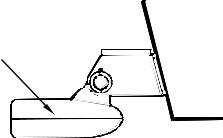
How low should you go?
For most situations, you should install your Skimmer transducer so that its centerline is level with the bottom of the boat hull. This will usually give you the best combination of smooth water flow and protection from bangs and bumps.
Transom
Transducer centerline
Hull bottom
Align transducer centerline with hull bottom.
However, there are times when you may need to adjust the transducer slightly higher or lower. (The slots in the mounting brackets allow you to loosen the screws and slide the transducer up or down.) If you frequently lose bottom signal lock while running at high speed, the transducer may be coming out of the water as you cross waves or wakes. Move the transducer a little lower to help prevent this.
If you cruise or fish around lots of structure and cover, your transducer may be frequently kicking up from object strikes. If you wish, you may move the transducer a little higher for more protection.
There are two extremes you should avoid. Never let the edge of the mounting bracket extend below the bottom of the hull. Never let the bottom – the face – of the transducer rise above the bottom of the hull.
Shoot-thru-hull vs. Transom Mounting
In a shoot-thru-hull installation, the transducer is bonded to the inside of the hull with epoxy. The sonar "ping" signal actually passes through the hull and into the water. This differs from a bolt-thru-hull installation (often called simply "thru-hull"). In that case, a hole is cut in the hull and a specially designed transducer is mounted through the hull with a threaded shaft and nut. This puts the transducer in direct contact with the water.
Typically, shoot-thru-hull installations give excellent high speed operation and good to excellent depth capability. There is no possibility of transducer damage from floating objects, as there is with a transommounted transducer. A transducer mounted inside the hull can't be knocked off when docking or loading on a trailer.
6
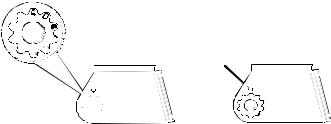
However, the shoot-thru-hull installation does have its drawbacks. First, some loss of sensitivity does occur, even on the best hulls. This varies from hull to hull, even from different installations on the same hull. This is caused by differences in hull lay-up and construction.
Second, the transducer angle cannot be adjusted for the best fish arches on your sonar display. (This is not an issue for flasher-style sonars.) Lack of angle adjustment can be particularly troublesome on hulls that sit with the bow high when at rest or at slow trolling speeds.
Third, a transducer CAN NOT shoot through wood and metal hulls. Those hulls require either a transom mount or a thru-hull installation.
Fourth, if your Skimmer transducer has a built in temp sensor, it will only show the temperature of the bilge, not the water surface temp.
Follow the testing procedures listed in the shoot-thru-hull installation section at the end of this segment to determine if you can satisfactorily shoot through the hull.
Transom Transducer Assembly and Mounting
The best way to install the transducer is to loosely assemble all of the parts first, place the transducer's bracket against the transom and see if you can move the transducer so that it's parallel with the ground.
1.Assembling the bracket. Press the two small plastic ratchets into the sides of the metal bracket as shown in the following illustration. Notice there are letters molded into each ratchet. Place each ratchet into the bracket with the letter "A" aligned with the dot stamped into the metal bracket. This position sets the transducer's coarse angle adjustment for a 14° transom. Most outboard and stern-drive transoms have a 14° angle.
Dot
Align plastic ratchets in bracket.
2. Aligning the transducer on the transom. Slide the transducer between the two ratchets. Temporarily slide the bolt though the transducer assembly and hold it against the transom. Looking at the transducer from the side, check to see if it will adjust so that its face is parallel to the ground. If it does, then the "A" position is correct for your hull.
7
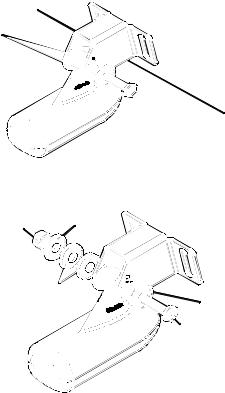
If the transducer's face isn't parallel with the ground, remove the transducer and ratchets from the bracket. Place the ratchets into the holes in the bracket with the letter "B" aligned with the dot stamped in the bracket.
Reassemble the transducer and bracket and place them against the transom. Again, check to see if you can move the transducer so it's parallel with the ground. If you can, then go to step 3. If it doesn't, repeat step 2, but use a different alignment letter until you can place the transducer on the transom correctly.
Ratchets
Insert bolt and check transducer position on transom.
Metal
Nut washer
Rubber |
Metal washer |
washers |
|
|
Bolt |
Assemble transducer and bracket.
3.Assembling the transducer. Once you determine the correct position for the ratchets, assemble the transducer as shown in the following figure. Don't tighten the lock nut at this time.
4.Drilling mounting holes. Hold the transducer and bracket assembly against the transom. The transducer should be roughly parallel to the ground. The transducer's centerline should be in line with the bottom of the hull. Don't let the bracket extend below the hull!
8
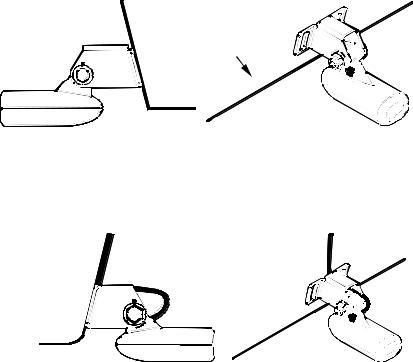
Mark the center of each slot for the mounting screw pilot holes. You will drill one hole in the center of each slot.
Drill the holes using the #29 bit (for the #10 screws).
Transom
Transom
Position transducer mount on transom and mark mounting holes. Side view shown at left and seen from above at right.
5. Attaching transducer to transom. Remove the transducer from the bracket and re-assemble it with the cable passing through the bracket over the bolt as shown in the following figures.
Route cable over bolt and through bracket. Side view shown at left and seen from above at right.
Attach the transducer to the transom. Slide the transducer up or down until it's aligned properly with the bottom of the hull as shown in the preceding and following figures. Tighten the bracket's mounting screws, sealing them with the sealant/adhesive compound.
Adjust the transducer so that it's parallel to the ground and tighten the nut until it touches the outer washer, then add 1/4 turn. Don't over tighten the lock nut! If you do, the transducer won't "kick-up" if it strikes an object in the water.
9

Bottom of hull
Flat-bottom hull |
Deep-"vee" hull |
Align transducer centerline with hull bottom and attach to transom.
6. Route the transducer cable through or over the transom to the sonar unit. Make sure to leave some slack in the cable at the transducer. If possible, route the transducer cable away from other wiring on the boat. Electrical noise from the engine's wiring, bilge pumps, VHF radio wires and cables, and aerators can be picked up by the sonar. Use caution when routing the transducer cable around these wires.
WARNING:
Clamp the transducer cable to the transom close to the transducer. This can prevent the transducer from entering the boat if it is knocked off at high speed.
If you need to drill a hole in the transom to pass the connector through, the required hole size is 5/8".
Caution:
If you drill a hole in the transom for the cable, make sure it is located above the waterline. After installation, be sure to seal the hole with the same marine grade aboveor below-waterline sealant/adhesive used for the mounting screws.
7. Make a test run to determine the results. If the bottom is lost at high speed, or if noise appears on the display, try sliding the transducer bracket down. This puts the transducer deeper into the water, hopefully below the turbulence causing the noise. Don't allow the transducer bracket to go below the bottom of the hull!
Trolling Motor Bracket Installation
1.Attach the optional TMB-S bracket to the transducer as shown in the following figure, using the hardware supplied with the transducer. (Note: The internal tooth washer is supplied with the TMB-S.)
10
